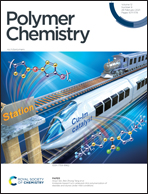Hard confinement systems as effective nanoreactors for in situ photo-RAFT: towards control over molecular weight distribution and morphology†
Abstract
This work highlights the development of a robust and universal route towards gaining control over macromolecule molecular weight, molecular weight distribution and, more importantly, morphology through the implementation of photoiniferter-mediated RAFT (photo-RAFT) carried out using mesoporous materials varying in the composition, pore arrangement, and pore diameters (metal–organic framework SBA-15 powder d = 5–15 nm, silica SiO2 templates d = 4 nm, alumina oxide AAO templates d = 10 nm). In fact, the application of these matrices that can act as nanoreactors for in situ UV-irradiated photo-RAFT of both commercial methyl methacrylate (more-activated monomer) and the synthesized N-vinyl-1,2,4-triazolium-based ionic liquid (less-activated monomer) is a key aspect of our approach. The collected data allowed us to probe the influence of the structural features of nanoreactors (i.e., transparency, porosity, roughness, and acidity) as well as confinement-related effects connected to variation in free volume and surface interactions on the polymerization path and properties of the produced ionic and non-ionic polymers. It was found that the application of all tested nanoreactors ensures greater control over photo-RAFT than analogous batch systems (macroscale photo-RAFT). However, running the reaction in mesoporous AAO templates offered by far the best control over the course of photo-RAFT of both the less-activated monomer (LAM) and the more-activated monomer (MAM) irrespective of the type of selected RAFT agent (switchable) (carbamodithioate vs. trithiocarbonate), their properties and, more importantly, the yield of the recovered polymers.



 Please wait while we load your content...
Please wait while we load your content...